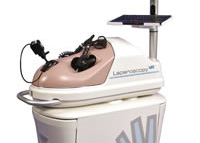Surgical simulators
Surgical simulators that impart the actual feeling of performing surgery provide obvious training benefits. Here’s how one company helps clinicians perfect the practice.
-

the LapVR™ System: The essential skills and procedures exercised while using the LaparoscopyVR Simulation System provide valuable training for surgical students prior to performing actual surgery.
Immersion Medical (Gaithersburg, MD) designs and manufactures surgical simulators. Similar in idea to that of flight simulators for pilots, a surgical simulator allows a medical student to practice an entire surgical procedure without the threat of harming a patient. Simulator training has also been found to reduce training costs because of procedural and instructor time savings, reduce errors resulting in fewer complications, and contribute to faster time to competence and reduced equipment damage, as well.
The company’s latest product offering in their simulation line is the LaparoscopyVR™ (LapVR) Virtual Reality Surgical Simulator. Designed by reviewing the Fundamentals of Laparoscopic Surgery curricula endorsed by the Society of American Gastrointestinal Endoscopic Surgeons, receiving input from surgeons at world renown institutions, and conducting in-depth research of training needs, the LaparoscopyVR Surgical Simulator provides a platform for virtual reality training. The system’s hardware and software interface simulates laparoscopic surgery and provides virtual reality training in the essential skills required of laparoscopic procedures. The simulator comes packaged as a complete system with selected software modules and height adjustable cart, monitor swing, foot pedal, camera and tools.
The LapVR Surgical Simulator’s recorded performance metrics allow medical institutions to assess individual and team performance. The simulator supports three fully instrumented tools—two trocars with interchangeable simulated tool tips and an endoscopic camera with 0, 30, and 45 degree lenses and high-speed optical tracking technology to accurately monitor tool motion.
Immersion completed the entire design and built of the device from the ground up, purchasing components from other vendors only when necessary. The base laparoscopy surgical simulator includes an Essential Skills module with fifteen skill exercises, a Laparoscopic Cholecystectomy (LapChole) module with eighteen cases and an Administration module that provides individualized instructional design and tracking. The Essential Skills module includes unique exercises for developing camera navigation, cutting, clipping, adhesiolysis, and hand transfer skills. The LapChole module provides a simulated environment for removal of the gall bladder, one of the most common types of laparoscopic surgeries in the U.S.
Using haptic, or force, feedback, the LaparoscopyVR system realistically emulates the feeling of the forces that would be encountered while performing laparoscopic surgery. This means that feedback while doing the simulation must be as close to reality as possible. Immersion calls this ‘Engaging the Sense of Touch”. The haptic feedback needed to generate that level of feeling required motors with very specific characteristics.
After researching the wide array of products available in the market, Immersion chose motors designed and manufactured by Maxon Precision Motors (Fall River, MA) for the project. “We use our motors in a unique way, different than how most standard motors are used,” said Rob Cohen, Director, Business Development for Immersion. Most DC motors are run at high speeds through transmission devices that are expected to generate the required forces, torques and speeds needed to drive a load, spin a tool or provide linear actuation. According to Rob, “Our application is different. We almost always run the motor in a stalled condition. The motor is not moving and that’s when we need it to generate torque.”
Furthermore, the company didn’t have the luxury of using high gear ratio transmissions because such devices must also be back drivable. That means that at appropriate times within the simulation, the user must be able to move the proxy surgical instrument without feeling any resistance or motor cogging. Maxon’s DC motors are known for their ability to run without cogging and with low background friction.
Additional features of Maxon’s DC motors with rare earth magnets include a rhombic, moving coil design, which provides for long life, low electrical noise, fast acceleration and high efficiency. It’s the ironless rotor that allows for the motors’ zero cogging and simple control.
Maxon motors are ‘torque dense’ as well, which means that for a given size motor and power, the components produce a lot of torque. This allows smaller motors in the Maxon line to produce a given output, all in a smooth, non-cogging design. Another benefit, non-technical in nature, to using Maxon components is that the company “…always delivers on time and frequently early, and we’ve never had an out of box failure,” Rob said.
The LaparoscopyVR virtual reality simulator provides the user with twelve degrees of freedom, ten of which are actuated with Maxon motors in them. Most of the motors are operated at zero speed and stall torque (or maximum continuous torque).
The tricky part of the design was heat management, according to Rob. “One of the motors used was located inside a plastic handle. The motor often ran near its thermal limit.” Because Immersion Medical uses motors in the scenario where they generate the most heat, a number of thermal management approaches were implemented in software to ensure the motors stayed within their operating envelope.
One area for improvement that’s always attractive to Immersion Medical is torque density. That is, is there a motor available in a smaller package that draws less current and produces more torque. As for documentation, Rob said that to someone trained in the skill of electromechanical design, Maxon’s printed materials are “…quite good and easy to use.”
© maxon precision motors, inc.
